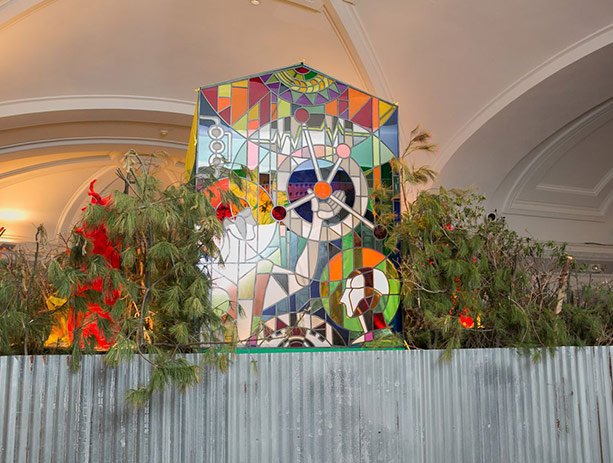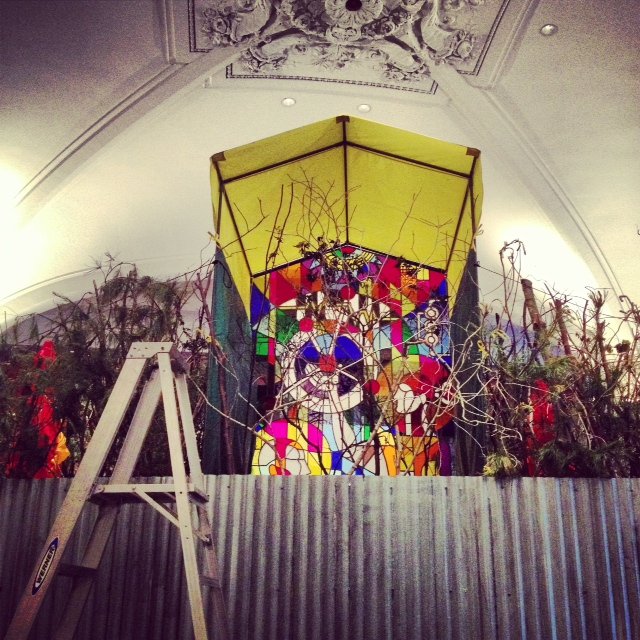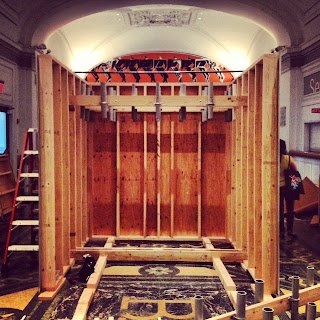Irina Korina: Chapel
In conjunction with TransCultural Express, Russian artist Irina Korina was invited to create and present an original work at BAM in June 2013. Korina is widely known for her large-scale installation pieces, mostly constructed from disposable, everyday material commonly found in Russia. About this site-specific piece, Chapel, the artist said it is “about new ideas which replaced the old ones and new confusions, about places of worship in a new society, and about old and new superstitions.” This marked Korina’s first major installation in the US and will be continuously displayed as part of BAM programming until September 1.
A Russian-English Glossary for Irina Korina’s “Chapel” by Brian Droitcour
Irina Korina’s sculptures address the bitter undercurrents of faith and nostalgia—the frustration that comes with longing for things that can never be seen or touched. She uses monumentality to conjure the grandness of collective belief, but she emphasizes the imposing inhumanity of monuments by making walls without openings and blocked lines of sight. Korina’s Chapel mimics the shape of a church but she has broken the church into components and replaced them with rhyming forms from everyday life, to locate the germ of transcendent belief in the ordinary, material experience of space and time.
While Korina intentionally makes confusion and frustration a part of the viewer’s experience, she also depends on her audience’s familiarity with her visual and formal references. Since many of them are particular to the Russian context, we offer this glossary to remove at least one layer of opacity from Chapel.
bytovka [быто́вка] n., coll.: a small auxiliary structure, like a shed, used for everyday needs at construction sites or homes, to store tools and other things. The word is formed by appending a suffix to byt (“everyday life”), a word derived from the verb byt’ (“to be”) that is terser than another kind of being, bytie (“transcendent existence”). Byt is material life; bytovka is a structure that serves it. See also: palatka, vremianka
chashcha [ча́ща] n.: thicket. A particularly dense growth of trees in a forest. Derived from the adjective chasty (“frequent”), it is a spatial concept with etymological links to temporality, sharing the root chas- (“hour,” “time”) with chasovnia (“chapel”). See also: sukhostoi
chasovnia [часо́вня] n.: chapel. A place of worship designated for private, small-scale prayer, rather than mass or liturgy. Derived from the root chas- (“hour,” “time”), it is a place for “serving the hours,” or saying daily prayers.
dolgostroi [долгостро́й] n., pej.: a construction project that goes on too long. The compound is composed of dolgo- (“long”) and stroi- (“build”); in the Soviet period the latter verb was commonly used metaphorically to describe political progress, i.e. “building communism.” Rhymes with sukhostoi. See also: vremianka, zabor
palatka [пала́тка] n.: a temporary structure consisting of a textile stretched over a frame, such as a tent used for camping in the woods. In the city a palatka is a pavilion, assembled for outdoor trade (the yellow-green steeple of Korina’s Chapel refers to these pavilions). In Moscow rows of tents are officially allowed only for weekend fairs, when traders come from the countryside to sell produce and wares. They are supposed to take their tents back with them when the weekend is done, but in neighborhoods outside the center the tents are frequently left through the week, forming abandoned encampments.
pozhar [пожа́р] n.: fire, not in the sense of an elemental flame but fire as an event. It can also be translated as “conflagration,” and like that word, pozhar is often used figuratively, to designate a catastrophe with drastic, rapidly spreading consequences.
sukhostoi [сухосто́й] n.: deadwood. A tree that has dried to its roots but still stands. Korina associates dead trees with yellowed newspaper photographs of demonstrations on the anniversary of the October Revolution, where crowds of people could be seen holding flags beneath autumnal canopies of leafless branches. Rhymes with dolgostroi. See also: chashcha
vitrazh [витра́ж] n.: colored mosaics in ornamental windows. Stained glass is uncommon in traditional Russian church architecture, hence the borrowing of the French vitrage in the eighteenth century, when ecclesiastical architecture was just one field where European practices were incorporated into Russian life. In the late Soviet period, geometric tableaux of colored glass became common; the religious function of stained glass—lending visibility to the light of God—easily migrated to Soviet secular humanist rhetoric of enlightenment. The stained-glass panel in Korina’s Chapel shows two scientists at work in a lab.
vremianka [время́нка] n., coll.: a makeshift temporary structure. Based on the root vremia (“time”), its folksy suffix solidifies time in a site, conveying the process by which ephemerality becomes habit, and brief events acquire long-lasting consequences. See also: bytovka, Palatka
zabor [забо́р] n.: fence. The word is derived from the verb zabrat’ (“to seize,” “to appropriate”). The post-Soviet period brought a proliferation of fences to privatize property that had previously been communal, as well as to mark the sites-in-progress of a new construction boom. The corrugated metal wall Korina’s Chapel is a cheap fence, perhaps a placeholder for a more handsome fence to be built later—but the rust suggests that it has already stood for too long. See also: dolgostroi
Irina Korina is a graduate of the Russian Theater Academy, Moscow, and Kunstakademie, Vienna. She was selected to represent Russia at the Venice Biennale in 2009 and will take part in Lost in Translation, a large-scale exhibition of contemporary Russian art which brings together over one hundred works made in the past forty years from the collection of MMOMA (Moscow Museum of Modern Art) during the 55th Venice Biennale in 2013.. Named to the 2010 residency at the Musée d'Art Contemporain du Val-de-Marne, Paris, Korina's work has been featured in solo exhibitions at Bloomberg Space, London; Moscow Museum of Modern Art; Museum Folkwang, Essen; and XL Gallery, Moscow. Group exhibitions include Garage Center for Contemporary Culture, Moscow; Centro per l'Arte Contemporanea Luigi Pecci, Prato; and Museum van Hedendaagse Kunst Antwerpen, Antwerp. Korina lives and works in Moscow.
Role: Commissioner/Curator
Date: June 5—September 1, 2013
Location: Peter Jay Sharp Building, Brooklyn Academy of Music, Brooklyn, NY
Artist: Irina Korina



